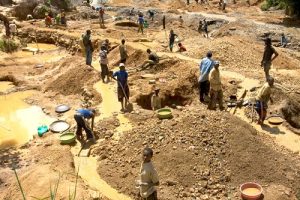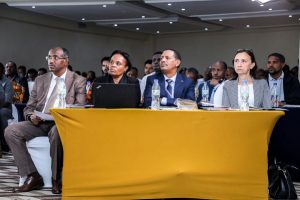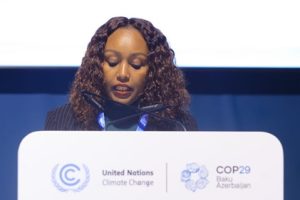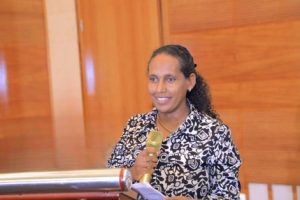BY GIRMACHEW GASHAW
In our day to day interaction with the environment, the relationship is established based on give and take principles. If nature withholds its daily activities, with no doubt, ecological imbalance has occurred as a result of which living things would not be able to breathe and die right away.
Thus, what should always be learned from this concept is that we (human beings) have to be optimistic about the land residing in and bestow what it claims from us.
Thus, human beings need to keep the ecological balance by contributing their share for the sustainability of the living environment. However, such efforts have not been seen in capital cities as industries and city dwellers highly polluting the environment human beings reside in releasing untreated wet waste to rivers.
Taking it as an enjoyable task, some people, who understand the aforesaid statement well, begin environmental protection efforts from home and scaled it up to city level. In this regard, it is imperative to mention the notable works of Dr. Araya Asfaw who is the founder and former Director of the Horn of Africa Regional Environment Center and Network (HoARECN) which was AAU’s programme.
The overall compound of his house is decorated by various plant species with power to bewitch any visitor. Araya said he used to sit in his park and read books. Similarly, he had been making various strides to protect the ecology of Addis Ababa and surrounding areas. Here are some of his views.
“If you look at Addis Ababa, there are a lot of problems associated with deforestation. When I was a Dean of Science Faculty my colleagues in the Department of Biology had been trying to establish a botanical garden but unfortunately did not materialize.
But it is really the most important concept because this botanical garden has much more significance in terms of protecting the environment as well. Hence, when we establish HoARECN, we propose to have a botanical garden in the capital and it could be used for education, recreation, tourism and various activities as well.
At the time, the Mayor of Addis Dr. Arkebe supported the idea. We initiated this idea and almost 800 hectares of land dedicated to be developed as a joint venture between Addis Ababa University and City’s Environmental Protection Authority.
Dr. Araya says the botanical garden idea was really to make it conservation of the environment. “And there are two advantages for that; one is, if you really afforest Addis Ababa, you can increase the water holding capacity of the city and even the underground water.”
And this could be an example how we restore the ecosystem by removing the eucalyptus which is taking a lot of water and regenerating the indigenous trees like the junipers and many others and so that if we can make this we can extend these to other areas around Addis.
The chain of mountains in Addis such as Entoto, Gulele, Yerer, Wochecha all those were 50, 60 year ago they were covered with forest, now because of human development, we lost all those forests and how can restore that back, Araya noted.
“When you restore this ecosystem, you also have to make sure that instead of displacing people, you create a livelihood that is compatible with natural conservation. So, Gulele is an example with 800 hectares of land but it needs to replicate around Addis Ababa” he noted.
So, we have quite an initiative from Gullele to Wochecha mountain restoration. We have quite a number of programmes there but it did not go as planned.
But I think there was some initiative that included Wochecha as part of the sustainable land management programme supported by GIZ. It has to be again included as the national programme because around Addis Ababa, you need to work with Oromia because it is again all these chains of mountains are in the jurisdiction of the state.
Gulelle botanic garden was an attempt to show how to caring for nature, conserve the forest and rehabilitate the degraded land. Finally, when people saw what has happened in Addis Ababa, then everybody was willing to promote the importance of reengineering.
In fact, the partnership with the city was inspired by Gulele and the city administration opened up since then to work collaboratively with AAU, Araya says. “We have been approached by the city to work on projects like Qoshe.
We are really concerned about the environmental impacts of Qoshe especially to the people who live around it and for that reason the City Administration requested us to develop a programme to properly close Qoshe and rehabilitate. And we even developed methane capturing – a carbon project for them and when Qoshe was closing – what do we do in its 40 hectares of land”
According to Araya, they agreed to build a park within the city and how do we transfer this damp site into a park. Just before the change, there was already a plan to transform that dam site into a park but then there was a problem because for that to happen another then you need another landfill one in Sendafa was already, but unfortunately because of the problem in Sendafa landfill not becoming operational. So, all of the work that we did at Qoshe just did not materialize.
But the city was highly impressed with what happened in Gulele. There was a plan we took for example when we proposed how to transform the Qoshe into a park, the city did not know exactly what we were talking about.
So, we arranged a tour in New York city- one of the whole damp sites, the damp site that served New York City was converted into a park. So, we decided to visit that and they understood what we were talking about.
So, the US Embassy and the State Department organized a trip for the mayor and city managers and also architects working on the design of Qoshe. So, when we came back Mayor Dirriba was so impressed that he committed to have 150 small, medium and large parks in Addis Ababa.
And all these parks were identified, in fact we had a design completion and based on that with the school of architecture in AAU and Architecture Association. So, the plan was to have small, medium and large neighborhood parks in all regions.
All this was inspired by what happened in Gulelle and now I am very happy to see even now this idea of dreaming well received by Prime Minister Abiy and also this river basin initiative was also initiated during the time of mayor Dirriba.
And in fact as part of the climate, when Addis Ababa was accepted as one of the resilient cities the river basin was one of the programmes supposed to be initiated. Anyway, with the Addis Ababa city, we have quite a number of programmes and very happy about that.
The Ethiopian Herald February 23/2021





